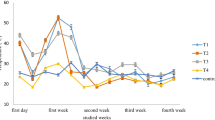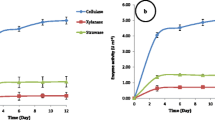Summary
Studies using cocultures of a cellulolytic fungus with a capsular organism show that microbial polysaccharides can be synthesized during the degradation of wheat straw. Polysaccharide accounted for up to 1.6% (w/w) of the initial straw weight but the sugar composition and viscosity indicated that a large fraction was low molecular weight material of plant origin. Nevertheless several cocultures produced sufficient microbial polysaccharide effectively to stabilize aggregates of Hamble silt loam. This correlated significantly with increased viscosity and also stabilization of Mount St. Helens volcanic ash. Four cocultures, Sordaria alcina with two strains of Enterobacter cloacae and a Pseudomonas sp. and Trichoderma harzianum with E. cloacae, were significantly more effective than a natural inoculum from straw. Inoculation of straw to produce a “compost” which can increase the stability of poorly structured soils is suggested.
Similar content being viewed by others
References
Acton CJ, Rennie DA, Paul EA (1963) The relationship of polysaccharides to soil aggregation. Can J Soil Sci 43:201–209
Chaney R, Swift RS (1984) The influence of organic matter on aggregate stability in some British soils. J Soil Sci 35:223–230
Chapman SJ, Lynch JM (1984) A note on the formation of microbial polysaccharide from wheat straw decomposed in the absence of soil. J Appl Bact 56:337–342
Chapman SJ, Lynch JM (1985) Some properties of polysaccarides of micro-organisms from degraded straw. Enzyme Microb Technol 7:161–163
Cheshire MV, Sparling GP, Mundie CM (1984) Influence of soil type, crop and air drying on residual carbohydrate content and aggregate stability after treatment with periodate and tetraborate. Plant and Soil 76:339–347
Domsch KH, Gams W (1972) Fungi in agricultural soils. Longman, London, p. 186
Dormaar JF, Pittman UJ, Spratt ED (1979) Burning crop residues: Effects on selected soil characteristics and long-term wheat yields. Can J Soil Sci 59:79–86
Dubois M, Gilles KA, Hamilton JK, Rebers PA, Smith F (1956) Colorimetric method for determination of sugars and related substances. Analyt Chem 28:330–356
Elliott LF, Lynch JM (1984) The effect of available carbon and nitrogen in straw on soil and ash aggregation and acetic acid production. Plant and Soil 78:335–343
Harper SHT, Lynch JM (1984) Nitrogen fixation by cellulolytic communities of aerobic-anaerobic interfaces in straw. J Appl Bact 57:131–137
Lynch JM, Elliott LF (1983) Aggregate stabilization of volcanic ash and soil during microbial degradation of straw. Appl Environ Microb 45:1398–1401
Lynch JM, Slater JH, Bennett JA, Harper SHT (1981) The cellulase activities of aerobic micro-organisms isolated from soil. J Gen Microb 127:231–236
Tisdall JM, Oades JM (1982) Organic matter and water stable aggregates in soils. J Soil Sci 33:141–163
Author information
Authors and Affiliations
Rights and permissions
About this article
Cite this article
Chapman, S.J., Lynch, J.M. Polysaccharide synthesis by capsular microorganisms in coculture with cellulolytic fungi on straw and stabilization of soil aggregates. Biol Fert Soils 1, 161–166 (1985). https://doi.org/10.1007/BF00301784
Received:
Issue Date:
DOI: https://doi.org/10.1007/BF00301784




